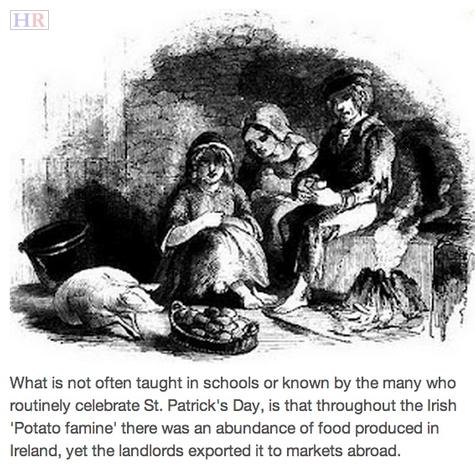The Real Irish American Story

The Real Irish American Story
by Bill Bigelow
"Wear green on St. Patrick's Day or get pinched."
That pretty much sums up the Irish American "curriculum" that I learned when I was in school. Yes, I recall a nod to the so-called Potato Famine, but it was mentioned only in passing. Yet there is no shortage of material that can bring these dramatic events to life . . . . In my high school social studies classes, I begin with Sinead O'Connor's haunting rendition of "Skibbereen," which includes the verse:
... Oh it's well I do remember, that bleak
December day,
The landlord and the sheriff came, to drive
Us all away
They set my roof on fire, with their cursed
English spleen
And that's another reason why I left old
Skibbereen.
Sadly, despite the fact that [the famine] was responsible for unimaginable suffering and the deaths of more than a million Irish peasants, and that it triggered the greatest wave of Irish immigration in U.S. history, [we do not] attempt to . . . link famines past and present.
Uniformly, social studies textbooks fail to allow the Irish to speak for themselves, to narrate their own horror. Nor do these texts raise any critical questions. For example, it's important to learn that the crop failure in Ireland affected only the potato -- during the worst famine years, other food production was robust. Michael Pollan notes in The Botany of Desire, "Ireland's was surely the biggest experiment in monoculture ever attempted and surely the most convincing proof of its folly." But if only this one variety of potato, the Lumper, failed, and other crops thrived, why did people starve?
Thomas Gallagher points out in Paddy's Lament, that during the first winter of famine, 1846-47, as perhaps 400,000 Irish peasants starved, landlords exported 17 million pounds sterling worth of grain, cattle, pigs, flour, eggs, and poultry -- food that could have prevented those deaths. Throughout the famine, as Gallagher notes, there was an abundance of food produced in Ireland, yet the landlords exported it to markets abroad.
More than a century and a half after the "Great Famine," we live with similar, perhaps even more glaring contradictions. Raj Patel opens his book, Stuffed and Starved: Markets, Power and the Hidden Battle for the World's Food System: "Today, when we produce more food than ever before, more than one in ten people on Earth are hungry. The hunger of 800 million happens at the same time as another historical first: that they are outnumbered by the one billion people on this planet who are overweight."
Patel's book sets out to explore what happens when food and land are regarded purely as commodities in a global system of profit. These are rich and troubling ethical questions. They are exactly the kind of issues that . . . allow [us] to see that history is not simply a chronology of dead facts stretching through time.
So go ahead: Have a Guinness, wear a bit of green, and put on the Chieftains. But let's honor the Irish with our curiosity. Let's make sure [to] show some respect, by studying the social forces that starved and uprooted over a million Irish -- and that are starving and uprooting people today.
Published on Thursday, March 15, 2012 by Common Dreams.
Bill Bigelow taught high school social studies in Portland, Ore. for almost 30 years. He is the curriculum editor of Rethinking Schools and the co-director of the Zinn Education Project.
Thank you for posting this, Susan. As noted in the article, the power and wealth inequities - brought into stark relief by the famine - are still in play today.
Patrick | 2014-03-17 03:44:19